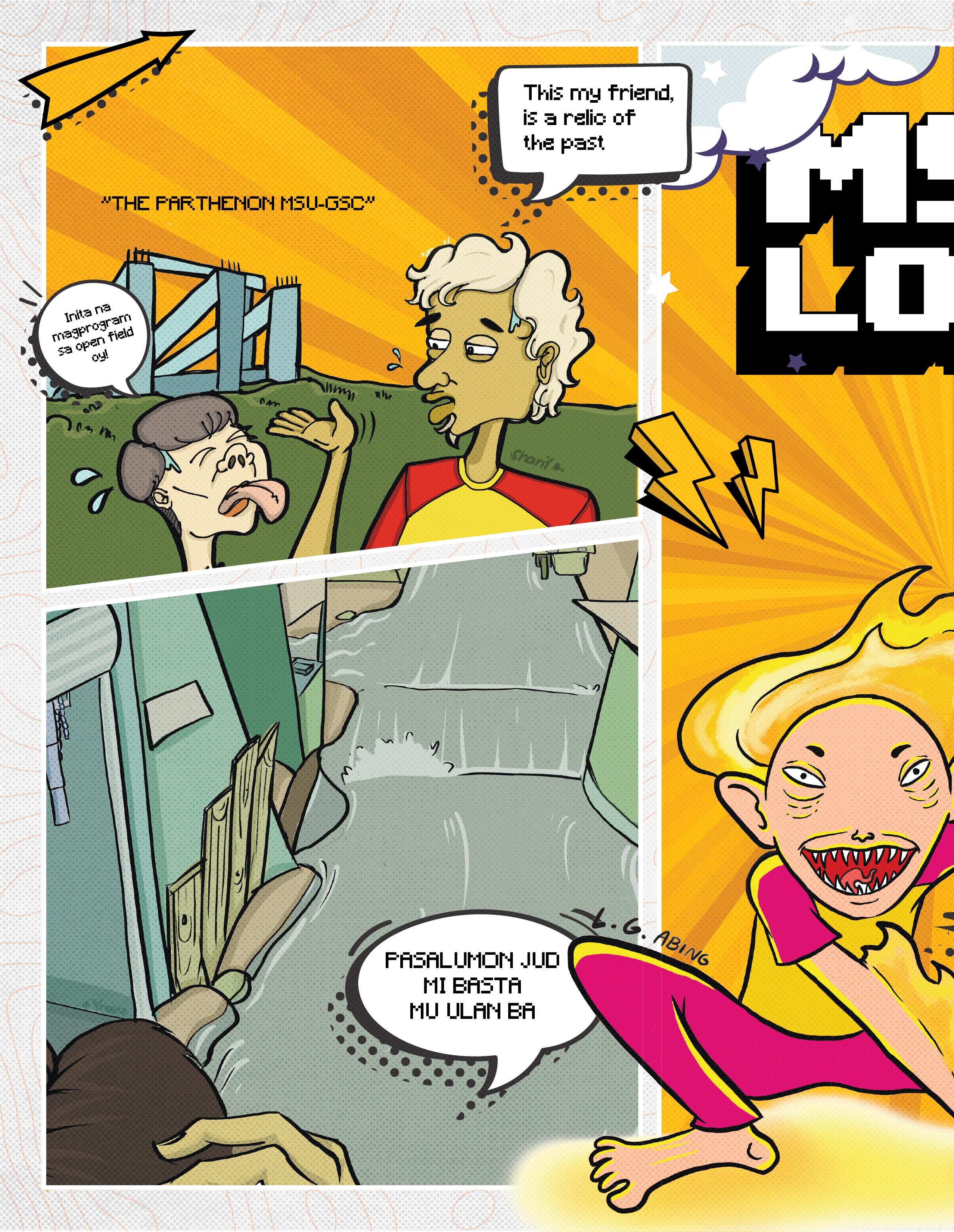
6 minute read
The waiting game resumes
Of how long we yearned to tread and stride the grandeur of MSU-Gensan— the frolic intramurals, the immanence of college life, and even the least of relish we get to have from entering the “Dakilang Pamantasan,” is the same story of how we longed to experience a new gymnasium that would cater to our highly anticipated institutional events. It is no doubt that most, if not all, students would certainly ask about the undone structure situated in the quadrangle of the institution. It could be recalled that during the activities of the first semester of the academic year 2022-2023, such as the opening salvo, general assemblies, and intramurals, the current university gymnasium could not accommodate the growing population of students and faculty. The limited capacity is a concern, and consequently, most of us have high hopes about its potential to become a better venue for conducting such huge events.
Tracing the historical foundation of the said project, it was at the time of former chancellor Atty. Abdurahman T. Canacan that the administration requested for the infrastructure to be built on the ground of the university through the funding of the Department of Public Works and Highways (DPWH), which is estimated at around P50 million. To clear it out, it was not part of the MSUGensan General Appropriations Act, thereby all transactions, management, and implementation were under the control of DPWH. In 2019, Phase 1 of the construction was carried out under the chancellorship of the late Dr. Anshari Ali. Yet a black swan event had brought a dramatic change to the status quo in the form of the COVID-19 pandemic that halted the million peso Phase 2 allocation. The enactment of RA 11469, or the “Bayanihan to Heal as One Act,” gave former president Rodrigo Duterte the authority to redirect funds from the Fiscal Year (FY) 2020 General Appropriations Act (GAA) towards initiatives to combat the pandemic’s effects. With the given pecuniary constraints faced by the national administration during the biological warfare, Vice-Chancellor for Planning and Development Shiela Loable elucidated during the interview that the Department of Budget and Management had been mandated to draw back the capital outlays to be used as funds in the course of the pandemic; hence, the school administration was held by the scruff of the neck due to the monetary impediment they had to face.
Advertisement
On the same note, she stated that the MSU-GSC alone could not fund the project given the increase in scholarship grantees at the time of the health crisis, which had put a crux on the budget apportionment of the office. Based on her statement, they were left with a small chunk of the pie after the deduction of stipends for the academic, cultural, and co-curricular scholarships. As per the estimates, in 2019, the scholarship fund accounted for around P3 million; in the following year, it rocketed to P7 million; and in 2021, it approximately swelled to P19 million. These are the facts where the office lied down their stand as to why there is still no single carpenter striking nails on the MSU quadrangle and also to beat some speculations arising from the deferred building construction.
In light of the effort made by the current management, Vice Chancellor Loable had put forward that they do not lose momentum in lobbying for the said project in higher authorities such as NEDA as well as with the posting senators and members of the House of Representatives. Along with the interview, Ms. Loable mentioned that Phase 2 of the completion of the university gymnasium is the top priority for the 2024 Program Budget Matrix with a proposed PHP 75 million fund. Despite its urgency and prioritization among the university projects, it is still bound to the national government if they approve the proposal since it is not anchored with the current 10-point policy agenda, and at the same rate, the Mandanas ruling also placed a substantial reformation on administrative financial autonomy on the current state of the nation. Now, the job is left to the higher governing body.
Thus, it could be inferred that the administration did not just let the iron rust. It just happened that refractory circumstances prompted the process. On the brighter side, the office expressed hope that by 2024, the scaffolding of new beginnings will be attached to the muchawaited MSU gymnasium. The student body yearned for this, and we hoped this would not be a promise of many tomorrows. We will keep an eye on this.
For now, the waiting game resumes.


TOO LITTLE TOO LATE?
WHERE PREVENTION ISN’T EVEN ENOUGH ANYMORE

Flabbergasted. The scorching heat truly isn’t helping people go by through their daily lives. Familiar for it’s witty little nickname, ”GenSun,” and how the citizens of the said city are increasing one by one, it was understandable that it was due to the coming waves of the yearly summer. Yet General Santos City might have welcomed it warmly a wee bit too much.
Starting 25th of March was when the heat rose day by day in the city. As mentioned, it was the beginning of summer, so the place was pretty much parched from rain. It started with a minimum of 33°C. However, the maximum heat came to 55°C by March 27th, which was certainly felt by the public then. This was based on the heat index posted by PAGASA on their official website.
Within the depths of Uhaw, Fatima, is proof.
As a student at Mindanao State University, it is a practice - and now a routine to most– that one has to walk from building to building for their designated classrooms. Inside the campus, it is known that most students have at least used an umbrella, if not, a hat to battle the scorching heat. If none of the above, then you’re pretty much at an advantage if one of your friends or classmates owns a motorcycle, or better, a four-wheeled vehicle. Aside from a faster way to travel, a student must also have a bottle of water or an aqua flask bottle present at all times.
A hack would be to have your water iced, but you’d be surprised that the ice has already melted by lunch time. The heat itself is no joke, as too many have experienced extreme sweat starting from 10am until the hours of 2pm. There were also cases of students passing out from the heat, and some having their noses bleed from the sudden temperature. Headaches were a common occurrence as well.
This was even before the supposed heat index was announced.
Fortunately, the university has considered and addressed the news of said heatwave and made classes online for a week. It lasted from March 27th until the end of the month.
Classes continued after and luckily for the students, the high index heatwave dissipated and went back to its casual 30 °C and above. Little do they know, as the end of April approaches, another heat index forecast was announced on April 23. Yet again the minimum was 33 °C, and by April 27th, the maximum heat was 55 °C, bared by PAGASA.
This time, the forecast degrees were a lot less than the ones announced around the end of March. The heat is still undeniable, however, with the Philippines being close to the equator and climate change adorning as a factor to that fact.
Beat the Heat! (Hopefully Anyway)
Aside from the aforementioned necessities and accessories to battle against said heat, there are still some options students of MSU may consider. Water – preferably cold water. It hydrates more than other beverages. However, cold juices and soft drinks are present within the campus, when said water is either drunk to the bottom or one forgets to refill and bring it in their persons.
Clothing is also another option. It is advisable to avoid darker and bold colors, specifically the color black, as it absorbs more heat. Light colors such as yellow, gray, and white are preferable. In terms of fabric, make sure to pick those of light and breathable ones: cotton, linen, silk and jersey. These fabrics allow air to flow freely through them. One should also choose clothing that is loose - those that move with you for extra comfort - to decrease sweating.
UPF-rated clothing is advised as well. Layering should be avoided. Accessories such as sunglasses and hats are to protect your eyes and your head, and wear shoes that are comfortable and breathable. To protect the skin, one may also apply sunscreen throughout the day.
“This (heat) is entirely different from back then.”
From this point on, the heat is rising, and we are yet to approach the centers of the summer season. We can still go back to the “reverse climate change” argument but we’re too late now.
Even then, it wouldn’t have hurt to have CHED announce another online class shift for a few days. Being at home is the safest option rather than having to burn your skin off to the rays of the unforgiving heat. The university itself doesn’t have air conditioned rooms, and most even have fans that don’t work. DEPED considered this for high school and lower graders, yet couldn’t even consider those of college students specifically living in a place named after the word thirst?
Another could be a hint of reconsideration to going back to the old school schedule. Yes, look, it’s the first face to face classes after almost two years of online paradigm and what-nots, yet hello? The world’s getting hotter, and we particularly aren’t getting stronger.
Years of arguments and none of us still give a sliver of a chance of prevention and dissemination of destruction to our own planet. We’re now experiencing the backlash of it now. Every scorching sunray that pains us is a hint that this planet is pulled to the abyss of its downfall. Should we still wait till this heat actually melts us, or maybe finally moving out of our selfish lives and into doing something?









